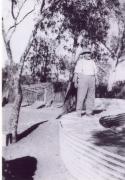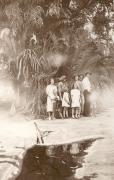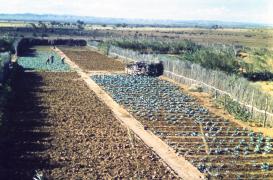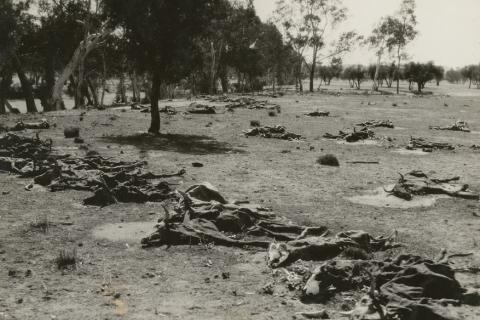The drought of 1927-29 was accompanied by a severe bout of scurvy which exacted a dreadful toll on the Hermannsburg community. However, no funds were forthcoming from the Church for the project, so private funds had to be raised by a tourist-turned-friend of the mission, Una Teague. She organised public appeals in Melbourne and Adelaide.
An accurate survey of the area by a Mr Horwood established that the difference in level between the Springs and the mission was 118 feet (36metres). The Commissioner of the Victorian State River and Water Supply Commission had previously been a guest of the mission and he was approached for assistance. One of his officers helped draw up the details of the scheme, and the mission was able to carry out the works commencing 10 December 1934, using Mr Latz to supervise the work and Mr Mattner to cement a trap near the spring and build the receiving tank. 1
Building the Kuprilya tank
The Kuprilya tank was built at the mission to receive the water. It was constructed of local materials using locally burnt lime, and stones and sand from the Finke River. It was plastered inside with a layer of cement. Arrarnta men of the mission dug the trench, which took an estimated 982 person weeks to complete. After working through the hottest months, finally, on 30 September 1935, the men completed laying the 2,092 sections of 11 feet (3.35 metres) pipes. The gravity fed water pipe from the springs to the mission was approximately 4.5 miles (7 kilometres) in length. The first water flowed to Hermannsburg the next day after an anxious night spent wondering if they had got the math right for the gravity feed. Altogether the pipeline and tank cost around £3,149 (approx. $5,872).
The water of life
While the tank alone was not enough water for all the needs for the mission it certainly improved the situation and allowed for a more reliable water source for the kitchen garden crops. With reliable water and adequate supplies of fresh fruit and vegetables assured, the child mortality rate dropped significantly. Albrecht later reflected
"How many graves could have been left undug if we had had the water during those long years of drought." 2
As one of his Aboriginal flock recalled
"When we saw that one, the water, we said, old man, your word is really true. I'll get it, he said. He did! Pastor Albrecht's word was true altogether." 3
The Kuprilya tank can be seen today at the Hermannsburg Historic Precinct.
- Schild, M 2007 Albrecht, Friedrich Wilhelm 1894–1984 Australian Dictionary of Biography, Volume 17, MUP.
- Henson B 1996 A Straight-out man Melbourne University Press, Carlton, p 96
Media










